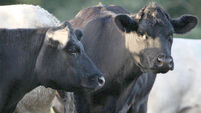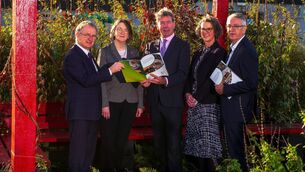Seasonal jump in cattle numbers and buyer activity
With nothing of note to distract the farming community, the focus shifts totally to plans for the coming winter.
Men with cattle to sell weigh their options, while winter finishers and store men plan their strategies.
The result has seen cattle numbers jump at marts this week, and increased buyer activity at most sales.
Beginning in Thurles, where Martin Ryan declared that Monday’s sale saw “savage prices being paid”.
The extra farmer buyers present, he said, lifted the trade significantly “especially for the continental cattle”. The only fly in the ointment, so to speak, was that the plainer Holstein/Friesian type animal continues to “under-perform”.
“The plainer Friesian type is under pressure,” he said. Leaving those aside, Thurles saw a very strong trade for all bullocks and heifers, with the heifers in particular “a great trade”, he said.
On the beef side, heavier bullocks performed well, with that sentiment also being reflected in the cull cow trade, “especially for the better finished cow”, Martin said. With a 98% clearance of the 835 animals present, a good number of purchasers went home with full loads or more.
The previous Friday saw a large sale in Carrick on Suir, where auctioneer Michael Cunningham said he presided over a “very good trade”.
“We had a lot of very good cattle in it,” he said.
The mart in Carrick draws the majority of its stock from South Tipperary, North Waterford and South Kilkenny, which are predominately dairy counties, So some days, like any other mart, you may get a share of more angular Friesian/Holstein animals present. That said, many dairy men in the region have over the years given serious consideration to the breeding of a more saleable animal. Michael confirmed this, “We had a lot of very good Friesians on Friday, and men to buy them”.
This was as much as I could get out of him before he went off on a rant about how great his native county, Kilkenny, were last Sunday. Like many — in relation to hurling — I have over the years learned selective deafness!
Moving to Tuesday and the sale in Nenagh where mart manager Michael Harty reported they had 760 animals, with a lot of bullocks on offer.
“The tone of the sale was quieter.” Friesian cattle in the 400 to 430 kilo bracket were “harder sold”, he said. The reason, he felt, was that a lot of buyers are still considering their options.
Some men, he said, don’t see the point of buying now, when they’ll have to put them into the shed in a few weeks. With beef at the factories starting to get “sticky” and the weather again deteriorating, there may be a certain logic to that thinking.
Turning the clock back one day to Monday, and the proceedings in Kilmallock , Denis Kirby informed me that their trade “was very good”. The autumn surge of potential customers saw “plenty of men wanting cattle”, Denis said.
It is his opinion that “mid-range stock are probably back in price to where they were a month ago, prior to the factory price pull”.
The better bullock however “hasn’t yet made up all the ground he lost, and could go more”, he said. The story with the poorer Friesian, however, is the same as everywhere else, “They’re a poorer animal, and they’re getting a poorer price,” he said.
With 1449 animals on show, it was a big sale, with Denis commenting they are expecting a run of similar size or bigger sales over the next four to five weeks.
Tralee on Monday also saw a bigger turn out of stock, with Philip Healy telling me they had their “biggest sale since the spring”.
“We had a very good selection of stock,” he said. With the exception of the cow trade which was “easier” (which he attributed to “men considering the quality of the animal and feed costs”), it was “a fine trade”, he said. The general run of Friesians fetched from €150 to €350 with the weight, while the Aberdeen Angus came in at €250 to €400 with the weight. Doing a little better were the Herefords, making from €360 to €450 with the weight, while their continental cousins pushed €2 a kilo.
When I spoke to Sean Leahy, manager of Corrin Mart about their Tuesday sale, the very first thing he said to me was, “I want it put in the paper that we are open for business next Tuesday”.
I said, “That’s the 9th, and the day of the proposed IFA protest in Dublin.”
“Yes,” he replied.
Turning back to their sale, he said they had “something short of 1,000 cattle on offer”. “It was a very big sale, possibly bigger than this time last year”.
“Trade was very strong, with the better end cattle having customers a plenty,” he said.
“Heifers were a shoot out, they were very dear,” he continued. The cow portion of the sale saw 100 animals go under the hammer with prices varying from €100 under to €500 over. “Prices for cows were up and down depending on the quality,” Sean said.
With a bigger attendance and cheque books strong, some buyers got into big numbers, as was the case in Thurles the day before. “We had lads who bought 30, 40 even 50,” the Corrin man said.
Monday also saw an increase in numbers down in Bandon, where Tom McCarthy said they also saw an “increase in customers”. Sellers “were largely very satisfied”, although “The men with the lighter plainer Friesian store got it tougher”. He noted that there were customers there for those types too, “but at a price”.
Tom considers, as do many others, that the current prices being paid for these plainer Holstein/Friesian types is governed more than ever by the relationship between their possible potential versus the availability of winter feed on farms, added to the high cost of concentrates. Sean also mentioned that the price of the over-30 month bullock “took a bit of a hit” on Monday.
On a more positive note, Skibbereen are having a weanling show and sale on Friday, and a good turn out is expected.
I finish this week with Sixmilebridge in Co Clare, and their sale last Saturday.
Mart manager Sean Ryan said their numbers continue to be very strong, although “heifers were scarce”. In relation to prices, he said, “The quality store animal of around the 400 to 500 kilo mark is very much in demand and is up in price.”
Plainer cattle “were not easily sold”, he said. Balancing that was the cow trade, which held “firm to good”, with factory buyers and farmers giving them good consideration, Sean said.
But the sale was dominated by very good prices for those aforementioned 400 to 500 kilo animals, as “the autumn men” made their presence felt. The prospect of an early and possibly long winter is already a reality on some farms in that part of the world, with Sean informing me that, “Cattle are already in for the winter in some places”.
It’s been a bad year just about everywhere, and I wonder what exactly the IFA leadership were thinking when they called for this protest on Tuesday next. Because as far as I could discover, the vast majority of sales yards that operate on Tuesdays will be keeping their gates open next week, despite the call on them to close.
As one mart man said to me, “To close our gates on Tuesday would be the height of irresponsibility in the light of the year that’s in it, and the absolute need farmers have to get stock off the land before the weather breaks for good.”













